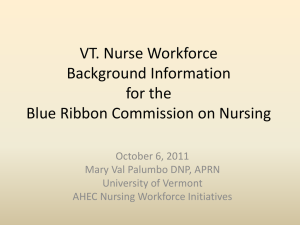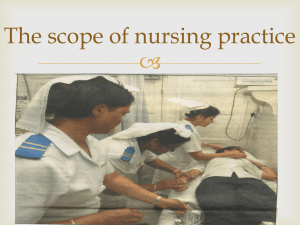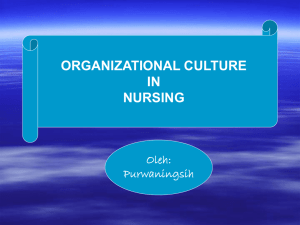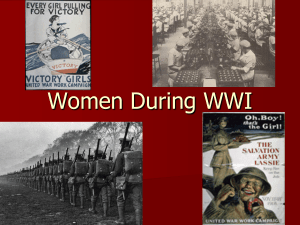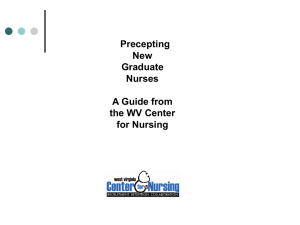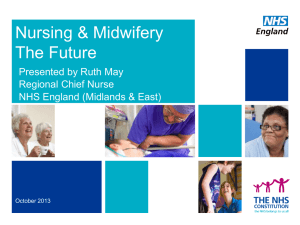Cohort 1 - California Workforce Association
advertisement
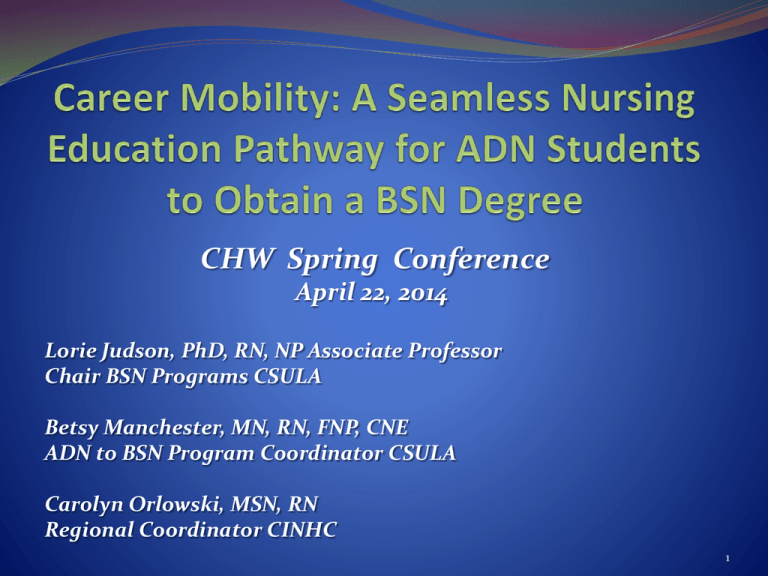
CHW Spring Conference April 22, 2014 Lorie Judson, PhD, RN, NP Associate Professor Chair BSN Programs CSULA Betsy Manchester, MN, RN, FNP, CNE ADN to BSN Program Coordinator CSULA Carolyn Orlowski, MSN, RN Regional Coordinator CINHC 1 Presentation Objectives 1. Identify needs and challenges related to advancing ADN to BSN education in California’s nursing workforce 2. Explore an emerging model of ADN to BSN education implemented at CSULA with 10 Community College Partners 3. Determine transferrable success strategies applicable to other programs that support and advance career mobility 2 California Institute for Nursing & Health Care (CINHC) www.cinhc.org Founded in 2001, a nonprofit 501©(3) independent organization dedicated to transforming the capacity of nurses to meet the evolving health needs of Californians Designated nursing workforce center for California Home of California Action Coalition accountable to carry out the Institute of Medicine Future of Nursing Recommendations CINHC partners with nursing leaders and health care organizations to develop practical solutions in 4 key areas: Statewide Master Plan (White Paper Nursing Education Redesign) Expanding educational capacity Increasing workforce & diversity recruitment and retention initiatives Developing nurse leaders capable in meeting challenges of a changing environment 3 California Picture: Substantial Progress in RN Workforce Growth 400,000+ Licensed RNs in California: 14% of USA (2013) 657 employed RN’s per 100,000 population California ranks low at 48 (National average = 825) Number of new RNs grew 83% past 10 years Workforce becoming more diverse in last decade - proportion non-white RNs increasing from 23% to 47% - proportion of males increasing from 5.8% to 11.6% BSN prepared RN candidates doubled (2001-2012) 86.3% increase - annual number RN to BSN program graduates over the last four years (1,600 graduates in 2012) 53% of the RN workforce holds a bachelor’s or higher degree 4 Snap Shot of New Graduate RN Hiring In California Hospitals (2013) Hospital vacancy rates trending low 3.8% (2013) Supply (# newly licensed RNs) and forecasted workforce demand (# of RNs needed) currently “in balance” Impact of economic crisis and shift in health care services are changing employment settings and hiring patterns 69% employed in hospitals 2012 (88% 2007) Statewide employer surveys reflect education hiring trends BSN preferred 68% or BSN required 7% Statewide survey of new RN graduates found differences in employment rates by type of degree (within first 12 months after receiving RN license) ADN 55% BSN 63% ELM 68% 5 The Future of Nursing: Leading Change, Advancing Health (Institute of Medicine Report 2009) 6 Institute of Medicine (IOM) under direction of Robert Wood Johnson Foundation (RWJF) commissioned report“The Future of Nursing: Leading Change, Advancing Health” Campaign for Action formed as a result by RWJF Center to Champion Nursing in America (CCNA) RWJF at AARP formed to implement the recommendations Action Coalitions formed across the US, now 51 of them [in CA- California Action Coalition (CAAC)] to work on implementing these recommendations at the state level National Recommendations and Campaign for Action 1. 2. 3. 4. 5. 6. 7. 8. Remove scope of practice barriers Expand opportunities for nurse to lead and diffuse collaboration Implement nurse residency programs Increase the proportion of nurses with BSN degrees to 80% by 2020 Double the number of nurses with doctorate by 2020 Ensure that nurses engage in lifelong learning Prepare and enable nurses to lead change to advance health Build an infrastructure for the collection and analysis of inter-professional health care workforce data 8 Registered Nurses: Potential to Effect Wide-Reaching Healthcare Change ! Largest component of health care workforce Spend most time with patients Understand care process across continuum of care Evidence links them to high-quality patient care 9 Compelling Challenges: Healthcare More nurses prepared at higher levels of education are needed to meet evolving healthcare demands Aging population, complex health management Health care reform with trends toward non acute care settings/home health/public health (BSN degree includes Community/Public Health Certification) Specialty care and advanced practice roles including primary care providers (APNs, Nurse Practitioners) Emerging “new "roles for nursing involving care coordination and managing patient populations Nursing faculty, leadership, and research positions F Compelling Challenges: Higher Educated Workforce Education mix of new graduates in California (2013 N=11,292) 57% ADN 37% BSN 6% ELM RN workforce with BSN or higher degree (increased 14.2% since 1990, relatively flat last 6 years) 54.1% (2006) 53.9% (2008) 53.2% (2010) 53.2% (2012) IOM Goal: 80% BSN or higher degree in RN workforce by 2020 California’s challenge: - Large ADN workforce (47% < BSN Degree or 188,888 nurses) - Large number of ADN graduates entering workforce each year - Barriers to return to school for higher degree (only 22% of RNs return) - Average time for ADN nurses who do obtain BSN degree: 9.4years - Limited number of RN to BSN programs in California: 33 programs (1,600 nurses graduated in 2013) and reduced state funding to CSUs - Workforce diversity gap compared to general population 11 California RN Diversity Snapshot Hispanic and Black RNs Underrepresented in Workforce 12 Projected Difference Between RNs and the General Population by Race 13 Ethnic Distribution California Pre-Licensure Nursing Students (5 primary groups) California BRN Annual School Report (May 2013) Ethnicity ADN LVN to ADN BSN ELM Total Asian 14% 10% 18% 25% 17% African American Filipino 6% 2% 4% 10% 6% 9% 16% 13% 3% 10% Hispanic 22% 15% 16% 13% 17% White 42% 44% 37% 39% 40% 14 Compelling Opportunity: Career Mobility and Increased Salary With BSN-MSN Degree Broader job opportunities in a greater range of settings Potential for promotion to specialized roles Annual income reported by California RNs (2012 USF Statewide Sample Survey conducted for the BRN) Degree or Role Associate Degree $84,839 Baccalaureate Degree $92,326 Master’s Degree $99,042 Public Health Nurse (BSN or MSN) $90,715 Nurse Practitioner (MSN) $93,493 Clinical Nurse Specialist (MSN) $100,482 15 Strategies and Initiatives to Advance Academic Progression (ADN to BSN) Implement emerging models for ADN to BSN Education Strengthen employer partnerships in academic program growth; increase clinical education capacity Provide financial and professional support to employees to return to school for BSN or MSN degrees Engage broad student interest to advance diversity Support academic success (K-12 and High School) and with currently enrolled nursing students - retention Expand funding - support for public school growth of BSN and MSN programs (CSUs) Increase BSN & MSN workforce through seamless access to various education pathway options 16 California Journey: Collaborative Model of Nursing Education (CCMNE) 17 Criteria for CA CMNE Dual Admission Integrated Curriculum & QSEN Share Faculty BSN Attainable in One Year after ADN Program Sustainability/Permanence California Collaborative Model of ADN to BSN Education (CCMNE) (CINHC sponsored model) 11/19 CSUs and 50/78 CCCs have implemented a dual enrollment CCMNE program with shared curriculum for streamlined ADN to BSN degree mobility AB 1295 signed into law requiring no duplication of coursework between CCCs and CSUs Leadership support from CSU & CCC Chancellors Offices to adopt and agree on BSN pre-requisites statewide; all CSUs developed ADN to BSN curriculum “roadmaps” Model leverages ethnic diversity found in Community College student population Model supports access for economically disadvantaged students to obtain a BSN degree Model reduces time and cost for students to obtain a BSN 19 Lorie Judson, RN, PhD, NP Associate Director CSULA SON Chair of BSN Programs Project Director , APIN LA Area Collaborative P. Betsy Manchester, MN, RN, FNP, CNE Coordinator APIN ADN/BSN Program RN-BSN has been an important mission of the SON for 60 years Several on-site programs during these years at area medical centers to educate nursing employees from ADN- BSN and BSN to MSN Alliance with several community colleges for transition programs have been made in various configurations Continue to provide a “traditional” RN-BSN program for working nurses through state support Increase the number of registered nurses educated at the baccalaureate (BSN) degree based on the Associate Degree (AD) as a foundation. Increase access to BSN education in a seamless, timely and cost effective manner. Increases number of nurses from economically and socially disadvantaged groups who have a BSN degree. Administered by the American Organization of Nurse Executives (AONE) on behalf of the Tri-Council for Nursing consisting of – American Association of Colleges of Nursing (AACN) National League for Nursing (NLN) American Nurse Association (ANA) These organizations represent nurses in practice, nurse executives and nurse educators Grant offered by RWJF - $300,000 for 2 years to Action Coalitions that could show they would increase the number of BSN nurses in their state Nine states chosen- California, Hawaii, Massachusetts, Montana, New Mexico, New York, North Carolina, Texas and Washington. California will focus on implementation of collaborative model of nursing education- CSULA and ten community colleges Campaign for Action - RWJF CCNA (The Center to Champion Nursing in America at AARP) 51 Action Coalitions 9 Action Coalitions with APIN Funding APIN Tri-Council * AONE - National Program AACN ANA NLN October 11, 2009- Governor signed this Assembly Bill Calls for systemic change requiring the Chancellor of the CSU to implement seamless articulated nursing degree pathways between California Community Colleges (CCC) and CSU prior to the 2012-2013 academic year. Removes system barriers to seamless progression of nursing education AB 1295 requires that by Fall 2012 the California State University AND the California Community College Chancellor’s Offices must implement “articulated nursing degree pathways.” No repeat of prerequisite courses or course content required for the ADN Identify additional components to be included that provide a streamlined nursing degree transfer pathway No duplication of BRN pre-licensure or ADN required course content CRITERIA AB 1295 CA CMNE Dual Admission Integrated Curriculum & QSEN “Articulated Nursing Degree Pathways” Share Faculty BSN Attainable in One Year after ADN No repetition of prerequisites or duplication of nursing course content required for licensure Permanence/ Sustainability Implied EDUCATION FOCUS Post-ADN/RN Licensure Concurrent ADN-BSN 50% 40% 30% 20 50% 28 40% 17 48% 20% 10% 0.5 7% 0% Caucasian Hispanic African American Asian Languages include Spanish, Vietnamese, Korean, Cambodian, Tagalog, Mandarin, French, Cantonese, Russian, Hindi , Armenian and more than 20 others Total Population (All Races) = 9,963,789 1.5% White, non Hispanic Black 48% 27% Asian Hispanic 14% 9.3% American Indian/ Alaskan Native Language other than English spoken at home, % age 5+, 2006-2010 = 56.4% Spurred by AB 1295 and CSU’s Chancellor’s Office Encouraged by CINHC and California Collaborative Model of Nursing Education Further impetus- IOM report and goals related to 80% BSN workforce by 2020 Planning for past two years- working out common prerequisites, curriculum and timing of course offerings Pre-requisites at Community College Admitted to Nursing program at CC Summer between two years of nursing at CC at CSULA Extended Ed Summer after completion of ADN -Pass NCLEX, Courses at CSULA Ex Ed Begin last year of BSN at CSULA Fall- Summer Roadmaps for each school on website Roadmaps Collaborative details- timing, portfolio content Coordinator Recruitment Advisement (financial and academic) Implementation Reporting California welcomes the first cohort of students in the APIN Program! Cohort 1: 69 Students 8 9 Cerritos Glendale 12 12 ELAC Long Beach Los Angeles City 10 9 9 Pasadena Rio Hondo Cohort 1 Race and Ethnicity 10% 9% 3% 29% Caucasian Hispanic 20% Asian 28% Filipino Two or More Races Other Race 17% Male 100% 30% Bachelor’s 80% 60% 83% Female 40% 70% No degree 26% Non-Native English 74% Native English 20% 0% Gender Previous Degree Language* Non-Native Languages: ▪ ▪ ▪ ▪ Armenian: 2 students Cantonese: 2 students Khmer: 1 student Korean: 1 student Russian: 2 students Spanish: 5 students Tagalog: 2 students Vietnamese: 3 students T-Shirt Facebook Page Officers Take Home Tools Use and enhance existing practices We built upon an existing collaborative model and developed it to fit our program needs Value CC educational foundation to meet RN workforce needs Build and foster relationships Open lines of communication Availability Inclusion Response 41 Take Home Tools, cont. Common vision We all held the same vision of achieving the BSN within 1 year of ADN graduation. Secondary vision was ADN program improvement and greater student success that would result from this relationship Participants identified as “Partners” Support / Approval Campus, State, Regulatory agencies, employers 42 Take Home Tools, cont. Collaboration Partners make collaborative decisions with CSULA for all critical program elements Individual ADN programs maintain authority for their students Evaluation per collaborative admission criteria Selection 43 Take Home Tools, cont. Transparency Critical program elements, including funding status, are communicated to our partners No mystery Respect Value of our partners is recognized and demonstrated by their participation in program development, revisions, implementation, etc. Student involvement Students are viewed and respected as partners 44 Take Home Tools, cont. Don’t re-invent. Re-kindle. Find your Champions. Build a trusted team. Always keep the “prize” in sight. Be flexible Recognize and acknowledge when something is not working Change it. Learn from it. 45 Take Home Tools, cont. Enjoy Always maintain a sense of humor!! 46 shared resources diversity and inclusion strategies inform and engage creative partnerships early start to future new options idea generation seamless education pathways transferrable strategies sustainable plans 47 Foster academic partnerships to streamline progression, increase shared capacity across academic entities and programs, with access or plans to continue education. “Early Start” – Start or complete pre-requisite coursework essential to next level of education as part of current education plan, with course credits for transferability. Inform, interest and engage all students in academic progression options to strengthen career mobility. 48 Utilize data on population based health disparities, medically underserved areas, and provider shortages to guide and fund priorities for action. Adopt diversity and inclusion strategies to align the healthcare workforce with the population - engage interest with ethnic minorities, conduct early outreach, strengthen academic success, provide mentoring, financial support. Provide or strengthen employer partnerships and support including financial (tuition reimbursement, stipends), professional (potential employment, career advancement), and other (flexible scheduling) 49

